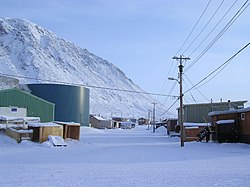Grise Fiord
ᐊᐅᔪᐃᑦᑐᖅ Aujuittuq | |
|---|---|
 Downtown Grise Fiord, March 2004 | |
| Coordinates: 76°25′00″N 082°53′45″W / 76.41667°N 82.89583°W[1] | |
| Country | Canada |
| Territory | Nunavut |
| Region | Qikiqtaaluk |
| Electoral district | Quttiktuq |
| High Arctic relocation | 1953 |
| Government | |
| • Mayor | Meeka Kiguktak |
| • MLA | David Akeeagok |
| Area | |
| • Total | 332.90 km2 (128.53 sq mi) |
| Elevation (at airport)[5] | 41 m (135 ft) |
| Population (2021)[4] | |
| • Total | 144 |
| • Density | 0.4/km2 (1/sq mi) |
| Time zone | UTC−05:00 (EST) |
| • Summer (DST) | UTC−04:00 (EDT) |
| Canadian Postal code | |
| Area code(s) | 867, Exchange: 980 |
Grise Fiord (/ɡriːz fiˈɔːrd/; Inuktitut: ᐊᐅᔪᐃᑦᑐᖅ, romanized: Aujuittuq, lit. 'place that never thaws') is an Inuit hamlet on the southern tip of Ellesmere Island, in the Qikiqtaaluk Region, Nunavut, Canada. It is one of three populated places on the island; despite its low population (144 residents at the 2021 Canadian census),[4] it is the largest community (and only public community) on Ellesmere Island. Created by the Canadian Government in 1953 through a relocation of Inuit families from Inukjuak, Quebec, it is Canada's northernmost public community. It is also one of the coldest inhabited places in the world, with an average yearly temperature of −16.5 °C (2.3 °F).
- ^ "Grise Fiord". Geographical Names Data Base. Natural Resources Canada.
- ^ "Municipal Election Results 2019-2020" (PDF). Elections Nunavut. Retrieved 26 December 2022.
- ^ "2021 General Election" (PDF). Elections Nunavut. Retrieved 26 December 2022.
- ^ a b c "Census Profile, 2021 Census of Population". Statistics Canada. Archived from the original on 27 September 2022. Retrieved 4 March 2022.
- ^ Canada Flight Supplement. Effective 0901Z 16 July 2020 to 0901Z 10 September 2020.

